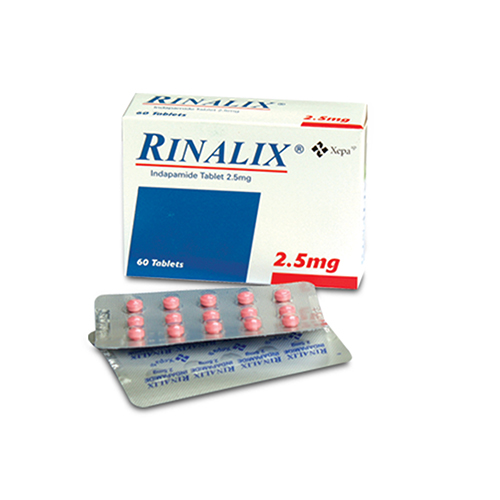
RINALIX Tablet
Therapeutic Class
Diuretics
Indications
Rinalix is indicated for the treatment of essential hypertension, alone or in combination with other antihypertensive drugs.
Chemical Composition
Indapamide 2.5 mg
Packaging
4 x 15's / Box
Dosage & Administration
To be administered orally. Hypertension: 2.5 mg daily, to be taken in the morning. The action of Indapamide is progressive and the reduction in blood pressure may continue and not reach a maximum until several months after the initiation of therapy. A larger dose than 2.5 mg Indapamide is not recommended as there is no appreciable antihypertensive effect but a diuretic effect may become apparent.
Contraindications
Anuria, stroke, recent cerebrovascular accident, severe hepatic insufficiency, known hypersensitivity to indapamide or to other sulfonamide-derived drugs.
Warning & Precautions
Hypokalemia, Hyponatremia, and Other Fluid and Electrolyte Imbalances: Periodic determinations of serum electrolytes should be performed at appropriate intervals. Patients should be observed for clinical signs of fluid or electrolyte imbalance, such as hyponatremia, hypochloremic alkalosis, or hypokalemia. Hyperuricemia and Gout: Serum concentrations of uric acid was reported to increase in patients treated with indapamide, and frank gout may be precipitated in certain patients receiving indapamide. Serum concentrations of uric acid should therefore be monitored periodically during treatment. Renal Impairment: Indapamide should be used with caution in patients with severe renal disease, as reduced plasma volume may exacerbate or precipitate azotemia. If progressive renal impairment is observed, withholding or discontinuing diuretic therapy should be considered. Renal function tests should be performed periodically during treatment with indapamide. Impaired Hepatic Function: Indapamide should be used with caution in patients with impaired hepatic function or progressive liver disease, since minor alterations of fluid and electrolyte balance may precipitate hepatic coma. Calcium Excretion: Calcium excretion is decreased by diuretics pharmacologically related to indapamide. Prolonged treatment with drugs pharmacologically related to indapamide may in rare instances be associated with hypercalcemia and hypophosphatemia secondary to physiologic changes in the parathyroid gland; however, the common complications hyperparathyroidism, such as renal lithiasis, bone resorption, and peptic ulcer, have not been seen. Treatment should be discontinued before tests for parathyroid function are performed. Like the thiazides, indapamide may decrease serum PBI (protein-bound iodine) levels without signs of thyroid disturbance. Use in Elderly: Plasma potassium and urate concentrations should be monitored when indapamide is used in elderly. Usage in Pregnancy: Reproduction studies have been performed in animals and have revealed no evidence of impaired fertility or harm to the fetus due to indapamide. There are, however, no adequate and well-controlled studies in pregnant women. Moreover, diuretics are known to cross the placental barrier and appear in cord blood. Therefore the drug should be used during pregnancy only if clearly needed. There may be hazards associated with this use such as fetal or neonatal jaundice, thrombocytopenia, and possibly other adverse reactions that have occurred in the adult. Nursing Mothers: It is not known whether this drug is excreted in human milk. Because most drugs are excreted in human milk, if use of this drug is seemed essential, the patient should stop nursing.

